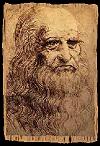|
Most of Leonardo's investigations into flight had the same major flaw; he assumed man had sufficient co-ordination and muscle power to copy bird flight. He was also much mistaken in another area, thinking that birds flew by beating their wings downwards and backwards. What actually happens is wing feathers provide thrust on the downstroke while the inner wing gives lift. Due to these incorrect conclusions Leonardo experimented endlessly with ideas which had no possible chance of being successful. He spent twenty-five years building wings based upon those of a bat and most of his work at this stage concentrated solely upon getting the flapping mechanism correct.
Though Leonardo did not often investigate how successful his 'motor' (a man) would be, he did invent a test rig for wings. His tests would most certainly have produced inaccurate results as the rig involved the pumping of only one wing whereas the pilot of an ornithopter has to cope with two wings. It is even thought one of Leonardo's designs may have been test flown as he wrote the following: "The great bird will take its first flight from Mount Ceceri which will fill the universe with amazement." Mount Ceceri was close to Leonardo's home and a legend exists that one of his students flew, crashed, and broke his leg. It should be remembered that this was the fifteenth century, a time when none of the basics of aerodynamics and flight were understood. It was known that lift was essential, but this was all. In fact, it was not to be until 1783 that the first hot-air balloon was successfully launched in France. It took until 1890 before heavier-than-air planes appeared. Leonardo had several designs for flapping wing aircraft (known as ornithopters) and this idea was among his earliest studies on flight. In 1487 he made drawings of a craft in which the pilot lay prone on a frame, his feet in stirrups. The motion of moving the feet together caused a downstroke from the wings. The upstroke was operated by a hand lever on the right front. Leonardo also made notes about the possibility of using a spring or pulling both feet up simultaneously to achieve the upstroke movement. Yet another design had the legs sliding up and down to control both movements and assisted by the hands which helped provide more power to the wing beat. Somewhere around 1486-1490 Leonardo produced drawings for an ornithopter with a sophisticated flight control system; the first in history. It depended upon a head harness which operated a combination rudder and elevator. This design appeared only twice in Leonardo's drawings and was not to reappear again in history until 1799, when another inventor used a similar system. In later life Leonardo dropped his experiments with flapping-wing aircraft and started working with more practical fixed-wing designs. For these he depended heavily upon studies of bird flight and falling leaves, but also invented the first ever anemometers and barometers to further aid his studies. Leonardo also produced sketches of a flying machine based upon a boat. The pilot was intended to lie stretched out and to pull at oars which would propel the craft through air rather than water. Several of Leonardo's designs for flying machines had the pilot, or pilots, standing. These cup-like machines would have required supermen to operate them. In one case the pilot was required to operate four wings by turning windlasses, using his hands and feet. He also had top push a piston up and down with his head. One of Leonardo's flying machines was particularly interesting in that the craft possessed an undercarriage and ladder which would be mechanically folded up after take-off. The design was totally impractical, but it can claim to be the first retractable undercarriage in history. This brings us to another problem faced by Leonardo. Every addition he made to his imaginative craft also added weight, making his task of flight more and more impossible. The components needed to power and lift an air craft simply did not exist in the time of the Renaissance. Leonardo's helicopter, made with an inefficient helical screw instead of rotor blades, could until recent times lay claim to being the first design of that type. However, it has now been established that the model helicopter was known of, and understood, prior to Leonardo's drawings. The first recorded toy of this type dates back to about 1320 and had a rotor based on windmill sails. Though his claim to first helicopter design has now been lost it is still likely Leonardo played a part in the development of the modern helicopter. It is said that Igor Sikorsky was shown Leonardo's work and this inspired him to take up the study of the helicopter, a field in which he became a world leader. Leonardo's first glider-type design did not allow for movement on the part of the pilot. He could not shift his body and legs so as to have some limited control of craft. Nor was the craft entirely of fixed wing design as the outer portion of the wing was still intended to be flapped. Of all his flying machines it is one of the very last which is most fascinating. Drawn less than ten years prior to Leonardo's death, it is the only one of his designs which is a true glider and shows the beginnings of controlled glider flight. In his description Leonardo says: "this [man] will move on the right side if he bends the right arm and extends the left arm; and he will then move from right to left by changing the position of the arms." This shows how far he had progressed, from imaginative, but impractical designs to ideas that had the potential to 'take off', as it were. |
|

